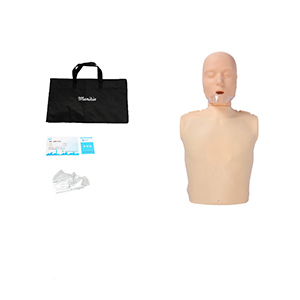Welcome to visitShanghai Chinon medical Model & Equipment Manufacturing Co., LTD
Cardiopulmonary resuscitation (CPR) is a key first aid method in response to cardiac arrest and is essential to improve survival rates. Traditional first aid training often relies on explanation and theoretical learning, but lacks practical operation opportunities, which makes students may lack the necessary operational experience and emergency response ability in emergency situations. The emergence of the simple half-body cardiopulmonary resuscitation simulator (hereinafter referred to as the "simple CPR simulator") makes up for this deficiency. By providing a simplified and efficient training platform, it not only improves the training effectiveness of first aid skills, but also has a profound impact on the entire field of first aid education.
Simple CPR Simulator: A key tool for effective training

Simple half-body cardiopulmonary resuscitation simulator
1. Simulation and convenience
Simple half-body cardiopulmonary resuscitation simulates the real situation of cardiac arrest by simulating functions such as chest response and airway management. Compared to traditional training models, simple CPR simulators take up less space and are easy to operate, making them ideal for frequent exercises and quick feedback in first aid training. Through the simulation operation, students can master the basic skills of cardiopulmonary resuscitation in the shortest time, such as the depth and frequency of chest compression, and the implementation of artificial respiration.
2. Market trend: Demand growth
With the popularization of cardiopulmonary resuscitation training, the simple half-body CPR simulator has gradually become a standard tool in various first-aid training courses. According to market research, the global cardiopulmonary resuscitation simulator market is expected to grow by approximately 15% over the next 5 years. Especially in the fields of medical care, education and corporate safety training, the simple half-body cardiopulmonary resuscitation simulator has become an important tool to improve the quality and efficiency of first aid training. Many medical institutions, schools and government first aid training institutions have begun to use such simulators to improve the popularity and quality of first aid training.
3. Data support: the training effect has been significantly improved
Studies have shown that the first aid accuracy and response speed of students trained with simple half-body CPR simulators are better than those trained without simulators. A study of 500 first-aid trainees showed that those who underwent simple CPR simulator training had a 27% increase in the accuracy of CPR operations and a 20% increase in the success rate of CPR under pressure. In addition, simulation training can help students form muscle memory, so that they can respond more quickly and accurately in the face of emergency situations.
4. Industry expert views
Many experts in the field of first aid believe that the application of simple half-body CPR simulators has greatly improved the efficiency and effectiveness of first aid training. Dr. Lisa Harris, first aid expert and medical trainer, said: "The simple CPR simulator not only allows students to practice theoretical knowledge, but also provides the opportunity to practice repeatedly, so that they can respond quickly in real emergency situations, thereby improving the overall success rate of emergency response." She also said that the ease and efficiency of simple CPR simulators is especially suitable for use in large-scale training, helping to quickly spread first aid skills.
5. Simplify training and reduce costs
Compared with the traditional first aid training model, the simple half-body CPR simulator not only has a high degree of imitation, but also pays attention to simplify the operation in the design. Its lightweight and easy maintenance features allow training institutions to reduce equipment procurement and maintenance costs. In addition, due to its small size, the Simple CPR Simulator is suitable for large-scale, widely distributed training Settings and can effectively reduce the overall cost of first aid training.
Clinical and social significance
The wide application of simple half-body cardiopulmonary resuscitation simulator not only improves the training effect of first aid skills, but also promotes the popularization of first aid education. Through the use of such simulators, more and more ordinary citizens and non-emergency professionals can master basic cardiopulmonary resuscitation skills, thereby improving the level of public first aid. Especially in the golden 4 minutes of cardiac arrest, the public is able to perform effective CPR operations in a timely manner, greatly increasing the chances of survival of patients.
Data show that survival rates for cardiac arrest have increased year by year through first aid training in communities and places such as schools. In one US study, residents of communities that received CPR training were 40% more likely to survive cardiac arrest than those that did not.
conclusion
The simple half-body cardiopulmonary resuscitation simulator is becoming the core tool in first aid training because of its high simulation and convenient characteristics. Whether in health care Settings, schools, or public safety training, simple CPR simulators show great potential. Through repeated practice, students can master cardiopulmonary resuscitation skills more effectively, and improve reaction speed and operational accuracy in real first aid scenarios. With the continuous growth of market demand and continuous progress of technology, simple half-body cardiopulmonary resuscitation (CPR) simulators will play an increasingly important role in the field of first aid training, promoting the popularization and standardization of first aid skills, and ultimately improving the survival rate of patients and the level of public safety.